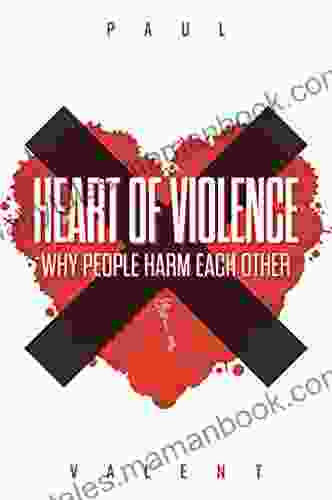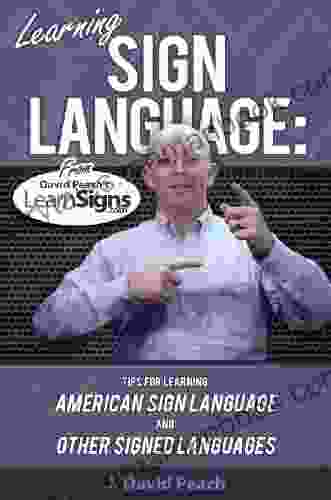The Heart of Violence: Understanding Why People Harm Others

Violence is a pervasive and devastating problem that has touched countless lives around the world. Whether it manifests as domestic abuse, school shootings, or international conflict, the consequences of violence are far-reaching and often irreversible.
While the causes of violence are complex and multifaceted, research has shed light on the various factors that can contribute to an individual's propensity to harm others. Understanding these factors is crucial for developing effective prevention and intervention strategies.
4.7 out of 5
| Language | : | English |
| File size | : | 2737 KB |
| Text-to-Speech | : | Enabled |
| Screen Reader | : | Supported |
| Enhanced typesetting | : | Enabled |
| Word Wise | : | Enabled |
| Print length | : | 65 pages |
| Lending | : | Enabled |
Biological Factors
Certain biological factors have been linked to an increased risk of violent behavior. These include:
- Genetics: Research suggests that some individuals may inherit a genetic predisposition to violence. Studies have identified specific genes that may be involved in aggressive and antisocial behaviors.
- Neurobiology: Differences in brain structure and function have also been associated with violence. For example, individuals with reduced activity in the prefrontal cortex, which is responsible for executive functions such as impulse control and decision-making, may be more likely to engage in aggressive behavior.
- Hormonal imbalances: Hormones such as testosterone and cortisol have been linked to aggression and violence. Elevated levels of testosterone, for instance, have been associated with a higher risk of physical aggression in males.
Psychological Factors
Psychological factors play a significant role in shaping an individual's potential for violence. These include:
- Personality traits: Certain personality traits, such as impulsivity, sensation-seeking, and low empathy, have been associated with an increased risk of violence. Individuals who are impulsive and have difficulty controlling their emotions may be more likely to act out aggressively when faced with perceived threats.
- Psychopathology: Mental health disorders, particularly antisocial personality disorder and psychopathy, have been strongly linked to violence. These disorders are characterized by a disregard for social norms and rules, lack of empathy, and a tendency to manipulate and exploit others.
- Trauma: Exposure to childhood trauma, such as physical, sexual, or emotional abuse, can significantly increase the risk of developing violent tendencies. Trauma can disrupt brain development, leading to impairments in emotional regulation and social functioning.
Social Factors
Social factors have a profound influence on an individual's propensity for violence. These include:
- Family environment: Growing up in a violent or abusive household can significantly increase the risk of becoming violent oneself. Children who witness or experience violence are more likely to develop aggressive and antisocial behaviors.
- Peer influence: Peers can play a significant role in shaping an individual's attitudes and behaviors. Involvement in gangs or exposure to delinquent peers can increase the risk of engaging in violent acts.
- Socioeconomic status: Poverty, unemployment, and other socioeconomic disadvantages have been linked to an increased risk of violence. These factors can lead to stress, social isolation, and a lack of opportunities, which can contribute to violent behavior.
Cultural Factors
Cultural factors can also influence the prevalence and nature of violence in a society. These include:
- Cultural norms and values: Cultures that glorify violence or promote aggressive behavior may increase the risk of violence. For example, societies that encourage "machismo" or the use of violence as a means of conflict resolution may have higher rates of interpersonal violence.
- Media: Exposure to violent media, such as movies, television shows, and video games, has been linked to an increased risk of aggression and violent behavior in children and adolescents. Media violence can desensitize individuals to violence and make them more likely to view it as an acceptable way to solve problems.
- Political instability: Countries experiencing political instability, such as war or civil conflict, often have higher rates of violence. This is due to a breakdown in social order, increased access to weapons, and a lack of law enforcement.
Understanding the causes of violence is a complex and ongoing endeavor. Biological, psychological, social, and cultural factors all play a role in shaping an individual's propensity to harm others.
By recognizing the multiple factors that contribute to violence, we can develop more effective prevention and intervention strategies. These strategies should focus on addressing biological risk factors, providing mental health support, creating positive family and social environments, promoting non-violent values, and reducing exposure to factors that increase the risk of violence.
Preventing and reducing violence requires a comprehensive approach that addresses both individual and societal factors. By working together, we can create a world where violence is no longer a pervasive threat but a rare exception.

4.7 out of 5
| Language | : | English |
| File size | : | 2737 KB |
| Text-to-Speech | : | Enabled |
| Screen Reader | : | Supported |
| Enhanced typesetting | : | Enabled |
| Word Wise | : | Enabled |
| Print length | : | 65 pages |
| Lending | : | Enabled |
Do you want to contribute by writing guest posts on this blog?
Please contact us and send us a resume of previous articles that you have written.
 Top Book
Top Book Novel
Novel Fiction
Fiction Nonfiction
Nonfiction Literature
Literature Paperback
Paperback Hardcover
Hardcover E-book
E-book Audiobook
Audiobook Bestseller
Bestseller Classic
Classic Mystery
Mystery Thriller
Thriller Romance
Romance Fantasy
Fantasy Science Fiction
Science Fiction Biography
Biography Memoir
Memoir Autobiography
Autobiography Poetry
Poetry Drama
Drama Historical Fiction
Historical Fiction Self-help
Self-help Young Adult
Young Adult Childrens Books
Childrens Books Graphic Novel
Graphic Novel Anthology
Anthology Series
Series Encyclopedia
Encyclopedia Reference
Reference Guidebook
Guidebook Textbook
Textbook Workbook
Workbook Journal
Journal Diary
Diary Manuscript
Manuscript Folio
Folio Pulp Fiction
Pulp Fiction Short Stories
Short Stories Fairy Tales
Fairy Tales Fables
Fables Mythology
Mythology Philosophy
Philosophy Religion
Religion Spirituality
Spirituality Essays
Essays Critique
Critique Commentary
Commentary Glossary
Glossary Bibliography
Bibliography Index
Index Table of Contents
Table of Contents Preface
Preface Introduction
Introduction Foreword
Foreword Afterword
Afterword Appendices
Appendices Annotations
Annotations Footnotes
Footnotes Epilogue
Epilogue Prologue
Prologue Dr Velma Bagby
Dr Velma Bagby Rachel Amphlett
Rachel Amphlett Michael Shaw
Michael Shaw Wil Adams
Wil Adams Andrew Keyt
Andrew Keyt Takaya Kagami
Takaya Kagami John Martin
John Martin Vivian Vande Velde
Vivian Vande Velde Jan Miller Burkins
Jan Miller Burkins Gary Wittmann
Gary Wittmann Lisa Mason Ziegler
Lisa Mason Ziegler Warren Nast
Warren Nast Sienna Frost
Sienna Frost Michael Stephen Fuchs
Michael Stephen Fuchs Sarah Marie Collins
Sarah Marie Collins Wayne Klein
Wayne Klein Robin Givhan
Robin Givhan Homer
Homer Jack Winter
Jack Winter David M Killoran
David M Killoran
Light bulbAdvertise smarter! Our strategic ad space ensures maximum exposure. Reserve your spot today!

 Alec HayesRescuing His Forever Folklore: A Heart-Warming Tale of Canine Compassion and...
Alec HayesRescuing His Forever Folklore: A Heart-Warming Tale of Canine Compassion and...
 Fred FosterSeven Bullets Acid Vanilla: A Comprehensive Guide to Its History, Production,...
Fred FosterSeven Bullets Acid Vanilla: A Comprehensive Guide to Its History, Production,... George HayesFollow ·3.2k
George HayesFollow ·3.2k Spencer PowellFollow ·12.6k
Spencer PowellFollow ·12.6k Robert ReedFollow ·6.2k
Robert ReedFollow ·6.2k Howard PowellFollow ·11k
Howard PowellFollow ·11k Corey GreenFollow ·16.1k
Corey GreenFollow ·16.1k Alec HayesFollow ·16.5k
Alec HayesFollow ·16.5k Mike HayesFollow ·18.8k
Mike HayesFollow ·18.8k Andy ColeFollow ·14.4k
Andy ColeFollow ·14.4k

 Edwin Cox
Edwin CoxThe Great Deliverance Inspector Lynley: A Literary...
: In the realm of detective fiction,...

 Christian Carter
Christian CarterMetal Gear Solid Ground Zeroes Guide, Walkthrough, Tips,...
Metal Gear Solid...

 Branden Simmons
Branden SimmonsYellow Green: Not an Autobiography of Marcy Chen
Yellow Green:...

 Edward Reed
Edward ReedPurple Orchids: An Artistic Tale of Two Sisters in the...
Prologue: A Legacy Unveiled In the...

 Earl Williams
Earl WilliamsThe Evolving Housing Market Dynamics in Africa:...
The African housing market is a...

 William Faulkner
William FaulknerVoices In My Head: A Cerebral Symphony of Terror
In the labyrinthine...
4.7 out of 5
| Language | : | English |
| File size | : | 2737 KB |
| Text-to-Speech | : | Enabled |
| Screen Reader | : | Supported |
| Enhanced typesetting | : | Enabled |
| Word Wise | : | Enabled |
| Print length | : | 65 pages |
| Lending | : | Enabled |








